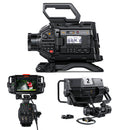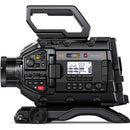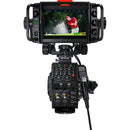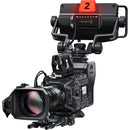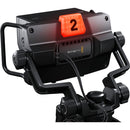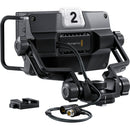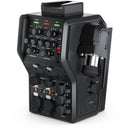Payment & Security
Your payment information is processed securely. We do not store credit card details nor have access to your credit card information.
Description
Blackmagic Design URSA Broadcast Studio Kit with Studio Viewfinder and Camera Fibre Converter - CINEURSAMWC4K-STUDIO
FEATURES
- 4K CMOS Sensor
- 7-inchStudio Viewfinder
- Camera Fibre Converter
- Compatible with 2/3" B4 Lenses
- UHD 4K and 1080p up to 60 fps
- Records to Apple ProRes and Avid DNx
- Cinema DNG Raw Recording
- 2 x UHS-II SD, 2 x CFast 2.0 Slots
- 3G-SDI and 12G-SDI Outputs
- Genlock and Timecode
- XLR Inputs and Built-In Microphone
URSA BROADCAST CAMERA
Two Cameras in One
Standard Media and Formats
B4 Lens Compatibility
HD Downscaling
Optical ND Filters
Body Design
Slow Motion Recording
Built-In Audio Recording
Adaptable for Different Lenses
Blackmagic OS
Flexible Power Options
Articulating Mount
7-inch LCD Viewfinder
Display
Manual Knobs
Menu and Function Buttons
Frame Guides
Tally
The Blackmagic Camera Fiber Converter attaches to the back of your URSA Mini or URSA Broadcast camera. In addition to converting all of the audio, video, camera control and talkback into fibre, it also adds professional studio camera controls to the back of your camera. You get control for return feeds, dual intercom controls with the ability to mix in program audio, record, focus and iris controls, headset connectors, audio and more. The camera converter also includes a VLock mount plate on the top for attaching accessories such as a professional Blackmagic Studio Viewfinder. The Blackmagic Camera Fiber Converter has connections for your Ultra HD camera feed, 3 HD return feeds, full remote camera control, PTZ, multiple channels of talkback, tally and more.
BLACKMAGIC FIBER CONVERTERS
Extend and fully power cameras up to 2 km away using an open standard SMPTE fibre cable
The Blackmagic Camera Fiber Converter and Blackmagic Studio Fiber Converter convert standard television industry connections for video, audio, power, talkback, and tally into a single SMPTE fibre optic cable. This allows cameras to be placed up to 2 km away from a studio or outside broadcast truck using a single convenient and incredibly durable cable. The Blackmagic Camera Fiber Converter also adds familiar broadcast studio camera controls to the rear of the camera, plus additional connections so you can use it with the talkback systems and switchers you already have. The Blackmagic fibre converters feature 12G-SDI and are designed to work with all HD and Ultra HD formats up to 2160p60. Now you can transform professional cameras such as URSA Broadcast and URSA Mini into a complete professional studio camera with all of the features you need for high-end work.
PLACE CAMERAS ANYWHERE
Get cameras much closer to the action
If you’re working in a studio or out at a large sporting venue, you often need to place cameras far apart. While SDI connections are common, the limited range of SDI makes it hard to use it over long distances. Traditionally, you would need to run multiple cables and expensive extenders for power, talkback, tally, video and audio. This makes the setup incredibly complex and increases the chances of a technical problem. Now you can solve this problem by converting all essential connections and power into a single convenient SMPTE fibre cable that can run incredibly long distances. That means cameras can be placed anywhere and connected back to broadcast trucks parked outside of a venue or back to a central control room in a studio. Best of all, SMPTE fibre is a global broadcast industry standard so you can use cables and connection points that are commonly available. Blackmagic fibre converters are also affordable, so traditional broadcasters, new web broadcasters, AV producers, houses of worship and educators can all use the same high-end broadcast technology.
SMPTE FIBER FOR INDUSTRIAL STRENGTH AND SAFETY
Built-in multi-layer fail safe instantly cuts power to eliminate the danger
Blackmagic fibre converters work with standard SMPTE 311M hybrid electrical and fibre optic cables with standard SMPTE 304 connectors on each end. These cables feature a 2-way fibre pair, data pair and power pair, along with a central strength member that gives it the needed durability for continuous use. Once plugged in, the Blackmagic Studio Fiber Converter automatically performs safety checks and then powers up, sending an industry-standard 200 volts of power over the SMPTE cable for the camera and accessories. This means you can install cameras in remote locations without having to worry about power drops over long distances. Both the studio and camera converters at each end have dedicated microcontrollers that continuously monitor power status. The converters communicate with each other to ensure that both a stable optical signal is present and that the power supply is operating within safe parameters. If a damaged cable or an earth leak is detected, the power is instantly shut down to eliminate any danger to personnel.
ADD STUDIO CAMERA CONTROLS
Transform broadcast cameras into dedicated studio cameras
Studio cameras are typically operated from the rear of the camera, but broadcast cameras usually have controls on the side of the camera. To solve this problem, the Blackmagic Camera Fiber Converter adds support for SMPTE fibre to your camera along with a wide range of controls and features to the rear of the camera, transforming it into a professional studio camera. You get 2 separate broadcast standard 5-pin talkback connections, 3 return video feeds, 2 extra audio inputs, connections for PTZ and trackers, plus additional DC and D-tap outputs for powering accessories. With all these extra controls added to the rear of the camera, you can operate the camera in the same way as traditional studio cameras.
10G ETHERNET FOR IP VIDEO
Super fast, low latency ethernet link for video, audio and control
The Blackmagic Camera Fiber Converter and the Blackmagic Studio Fiber Converter use IP video because the SMPTE fibre connection is an open standard 10G Ethernet link. That means all of your video and return feeds are IP video-based using high-end, lossless broadcast quality 10-bit video encoding and decoding. All other connections such as talkback, tally, camera control and lens control are also converted to low latency IP so you get incredibly reliable performance and high quality. Using IP video means the Blackmagic fibre converters are future-proof and ready for customization using high-speed Ethernet infrastructure in future.
DUAL CHANNEL TALKBACK
Two dual-channel talkback intercoms with backup
The Blackmagic Camera Fiber Converter and Blackmagic Studio Fiber Converter provide 2 dual channel digital talkback connections that are compatible with professional 5-pin XLR talkback headsets. The camera converter even has convenient controls for mixing in program return audio with your talkback headset so you can adjust the volume as needed while talking to the rest of the crew. The talkback intercoms can be used for both production and engineering. In addition, there is a backup channel available for troubleshooting in case the fibre link is down. This backup talkback channel automatically switches over and uses the data pair in the SMPTE cable if the fibre is not working. The Blackmagic Camera Fiber Converter also includes a standard 10-pin connection for tracker talkback, which is perfect when both headset connections are in use and you need to feed an additional talkback connection through to your crane operator.
DESIGNED FOR HIGH-END BROADCAST
Durable metal design, high-end components and professional connections
The Blackmagic Camera Fiber Converter features an extremely durable all-metal design that perfectly matches URSA Broadcast, URSA Mini cameras or any camera that supports a standard battery plate. It’s built to withstand the harsh demands of outdoor field production and 24/7 operation. The Blackmagic Camera Fiber Converter features full-size standard television industry connections with dust caps, along with an integrated VLock mount plate on top for adding a studio viewfinder. The Blackmagic Studio Fiber Converter is designed so that you can fit two of them side by side in a standard equipment rack using the optional rack mount kit. The optical fibre connector on the Blackmagic Studio Fiber Converter is conveniently located on the front panel, right next to the built-in 5-inch LCD, so you can plug remote cameras in and instantly see the feed.
| Camera Features | |
| Effective Sensor Size | 2/3 inch sensor size when using 4K B4 mount (Actual sensor size 23.10mm x 12.99mm) |
| Lens Mount | B4 2/3 inch installed |
| Active EF mount also included | |
| Lens Control | Electronic control via 12-pin broadcast connector. Control via EF mount pins when using URSA Mini Pro EF Mount with compatible EF lenses. |
| Lens Correction | In-camera correction of color fringing when using compatible broadcast lenses. |
| Dynamic Range | 13 Stops |
| Dual Native ISO | 0dB and 18dB gain. |
| Sensitivity at 0dB Gain | f11 with 2160p59.94. |
| f12 with 2160p50. | |
| at 2,000 lux with 89.9% reflectance. | |
| additional 1.1 stop light loss using 4K B4 mount. | |
| Signal to Noise Ratio | 64.62dB for 2160p |
| Ultra HD scaled from 5.3K | |
| Built in ND Filters | Four position ND filter wheel with clear, 2 stop, 4 stop and 6 stop ND filters. |
| Focus | Focus button triggers auto focus when using compatible lenses with focus servo. Touch and hold on LCD determines focus region and triggers auto focus. |
| Iris Control | Iris wheel and touchscreen slider for manual iris adjustment on electronically controllable lenses, iris button for instant auto iris settings on compatible lenses so no pixel is clipped in film mode. Scene average auto exposure in video and extended video mode. |
| Screen Dimensions | 4 inch |
| Screen Type | LCD capacitive touchscreen. |
| Controls | Touchscreen menus on 4 inch screen. Push buttons for other controls. 3 assignable shortcut keys and 2 assignable shortcut keys (VTR and RET) on compatible broadcast lenses. |
| ProRes Shooting Resolutions and Frame Rates | 3840 x 2160 (Ultra HD) up to 60 fps from Ultra HD window or scaled from 5.3K windowed sensor |
| 3840 x 2160 (Ultra HD) up to 50 fps scaled from full sensor | |
| 1920 x 1080 (HD) up to 120 fps scaled from 2.7K windowed sensor | |
| 1920 x 1080 (HD) up to 60 fps scaled from Ultra HD or 5.3K windowed sensor | |
| 1920 x 1080 (HD) up to 50 fps scaled from full sensor | |
| H.265 Shooting Resolutions and Frame Rates3840 x 2160 (Ultra HD) up to 60 fps from Ultra HD window or scaled from 5.3K windowed sensor | |
| 3840 x 2160 (Ultra HD) up to 50 fps scaled from full sensor | |
| H.264 Shooting Resolutions and Frame Rates | 1920 x 1080 (HD) up to 60 fps scaled from Ultra HD or 5.3K windowed sensor |
| 1920 x 1080 (HD) up to 50 fps scaled from full sensor | |
| Blackmagic RAW Shooting Resolutions and Frame Rates | 6144 x 3456 (6K) up to 50fps |
| 6144 x 2560 (6K 2.4:1) up to 60 fps | |
| 5376 x 3024 (5.3K 16:9) up to 60 fps | |
| 3728 x 3104 (3.7K 6:5 anamorphic) up to 60 fps | |
| 3840 x 2160 (Ultra HD) up to 60 fps | |
| 1920 x 1080 (HD) up to 150 fps | |
| Project Frame Rates | 23.98, 24, 25, 29.97, 30, 50, 59.94 and 60 fps. |
| Off-speed frame rates up to 60p in Ultra HD and up to 150p in HD. | |
| Metadata Support | Automatically populated lens data from electronic B4 lenses. Automatic recording of camera settings and slate data such as project, scene number, take and special notes. |
| Timecode Clock | Highly accurate timecode clock. Less than 1 frame drift every 8 hours. |
| Connections | |
| SDI Video Inputs | 1 |
| SDI Video Outputs | 1 |
| SDI Monitor Outputs | 1 |
| SDI Rates | 1.5G, 3G, 6G, 12G. |
| Analog Audio Inputs | 2 x XLR switchable between mic, line and AES digital audio. |
| Phantom power support. | |
| Analog Audio Outputs | 1 x 3.5mm headphone jack, supports iPhone style headset for talkback. |
| Reference Inputs | Tri-Sync/Black Burst/Timecode. |
| Lens Control | 1 x 12-pin Hirose Broadcast Lens Connector |
| Remote Control | 1 x 2.5mm LANC input for Rec Start/Stop, plus Iris and Focus control using compatible lenses. |
| Computer Interface | 1 x USB Type‑C 3.1 Gen 2 with power delivery for external drive recording and connecting Blackmagic Focus and Zoom Demand. |
| 1 x USB Type‑C for software updates. | |
| Audio | |
| Microphone | Integrated stereo microphone. |
| Built in Speaker | 1 x mono speaker. |
| Standards | |
| SD Video Standards | None |
| HD Video Standards | 1080p23.98, 1080p24, 1080p25, 1080p29.97, 1080p30, 1080p50, 1080p59.94, 1080p60 1080i50, 1080i59.94, 1080i60 |
| Ultra HD Video Standards | 2160p23.98, 2160p24, 2160p25, 2160p29.97, 2160p30, 2160p50, 2160p59.94, 2160p60 |
| SDI Compliance | SMPTE 292M, SMPTE 424M, SMPTE 425M level A and B, SMPTE 2081‑1, SMPTE 2081‑10, SMPTE 2082‑1 and SMPTE 2082‑10 |
| SDI Audio Sampling | 48 kHz and 24 bit |
| Media | |
| Media | 2 x CFast 2.0 card slots, 2 x SD UHS‑II card slots, 1 x USB‑C 3.1 Gen 2 expansion port with power delivery for recording to external media. |
| Media Format | Can format media to ExFAT for Windows and Mac or HFS+ for Mac (file systems). |
| Supported Codecs | |
| Codecs | Apple ProRes 422 HQ, |
| Apple ProRes 422, | |
| H.265 SDI (10-bit 4:2:2), | |
| H.265 High (10-bit 4:2:0), | |
| H.265 Medium (10-bit 4:2:0), | |
| H.265 Low (10-bit 4:2:0), | |
| H.264 SDI (10-bit 4:2:2), | |
| H.264 High (8-bit 4:2:0), | |
| H.264 Medium (8-bit 4:2:0), | |
| H.264 Low (8-bit 4:2:0), | |
| Blackmagic RAW Constant Bitrate 3:1, | |
| Blackmagic RAW Constant Bitrate 5:1, | |
| Blackmagic RAW Constant Bitrate 8:1, | |
| Blackmagic RAW Constant Bitrate 12:1, | |
| Blackmagic RAW Constant Quality Q0, | |
| Blackmagic RAW Constant Quality Q1, | |
| Blackmagic RAW Constant Quality Q3, | |
| Blackmagic RAW Constant Quality Q5 | |
| Control | |
| External Control | Lens control of compatible lenses using Blackmagic Zoom Demand and Blackmagic Focus Demand, Blackmagic SDI Control Protocol, iPad control via Bluetooth, 1 x 2.5mm LANC for lens and record control. |
| Color Corrector | |
| Color Corrector | DaVinci YRGB. |
| Talkback and Tally | |
| Talkback | SDI Channels 15/16 and iPhone headset. |
| Live Tally Indicator | Tally on LCD, URSA Viewfinder and URSA Studio Viewfinder. |
| Storage Features | |
| Storage Type | 2 x CFast 2.0 |
| 2 x SD UHS‑II cards | |
| 1 x high speed USB‑C expansion port for external media. | |
| 2.5 inch SSD using optional URSA Mini Recorder | |
| Storage Rates | Storage rates based on 30 frames per second. |
| 6144 x 3456 (6K) | Blackmagic RAW 3:1 - 323 MB/s |
| Blackmagic RAW 5:1 - 194 MB/s | |
| Blackmagic RAW 8:1 - 121 MB/s | |
| Blackmagic RAW 12:1 - 81 MB/s | |
| Blackmagic RAW Q0 - 242 to 483 MB/s | |
| Blackmagic RAW Q1 - 162 to 387 MB/s | |
| Blackmagic RAW Q3 - 108 to 277 MB/s | |
| Blackmagic RAW Q5 - 65 to 162 MB/s | |
| 6144 x 2560 (6K 2.4:1) | Blackmagic RAW 3:1 - 240 MB/s |
| Blackmagic RAW 5:1 - 144 MB/s | |
| Blackmagic RAW 8:1 - 90 MB/s | |
| Blackmagic RAW 12:1 - 60 MB/s | |
| Blackmagic RAW Q0 - 180 to 359 MB/s | |
| Blackmagic RAW Q1 - 120 to 287 MB/s | |
| Blackmagic RAW Q3 - 80 to 205 MB/s | |
| Blackmagic RAW Q5 - 49 to 120 MB/s | |
| 5376 x 3024 (5.3K 16:9) | Blackmagic RAW 3:1 - 248 MB/s |
| Blackmagic RAW 5:1 - 149 MB/s | |
| Blackmagic RAW 8:1 - 94 MB/s | |
| Blackmagic RAW 12:1 - 63 MB/s | |
| Blackmagic RAW Q0 - 186 to 371 MB/s | |
| Blackmagic RAW Q1 - 125 to 297 MB/s | |
| Blackmagic RAW Q3 - 84 to 213 MB/s | |
| Blackmagic RAW Q5 - 51 to 125 MB/s | |
| 3728 x 3104 (3.7K 6:5 anamorphic) | Blackmagic RAW 3:1 - 177 MB/s |
| Blackmagic RAW 5:1 - 106 MB/s | |
| Blackmagic RAW 8:1 - 67 MB/s | |
| Blackmagic RAW 12:1 - 45 MB/s | |
| Blackmagic RAW Q0 - 133 to 265 MB/s | |
| Blackmagic RAW Q1 - 89 to 212 MB/s | |
| Blackmagic RAW Q3 - 60 to 152 MB/s | |
| Blackmagic RAW Q5 - 36 to 89 MB/s | |
| 3840 x 2160 (Ultra HD) | Apple ProRes 422 HQ - 110 MB/s |
| Apple ProRes 422 - 73.6 MB/s | |
| H.265 SDI - 12.3 MB/s | |
| H.265 High - 10.8 MB/s | |
| H.265 Medium - 7.8 MB/s | |
| H.265 Low - 3.2 MB/s | |
| Blackmagic RAW 3:1 - 127 MB/s | |
| Blackmagic RAW 5:1 - 77 MB/s | |
| Blackmagic RAW 8:1 - 48 MB/s | |
| Blackmagic RAW 12:1 - 32 MB/s | |
| Blackmagic RAW Q0 - 96 to 190 MB/s | |
| Blackmagic RAW Q1 - 64 to 153 MB/s | |
| Blackmagic RAW Q3 - 43 to 109 MB/s | |
| Blackmagic RAW Q5 - 26 to 64 MB/s | |
| 1920 x 1080 | Apple ProRes 422 HQ - 27.5 MB/s |
| Apple ProRes 422 - 18.4 MB/s | |
| H.264 SDI - 7.0 MB/s | |
| H.264 High - 5.6 MB/s | |
| H.264 Medium - 3.2 MB/s | |
| H.264 Low - 1.8 MB/s | |
| Blackmagic RAW 3:1 - 19 MB/s | |
| Blackmagic RAW 5:1 - 12 MB/s | |
| Blackmagic RAW 8:1 - 7.8 MB/s | |
| Blackmagic RAW 12:1 - 5.2 MB/s | |
| Blackmagic RAW Q0 - 23 to 47 MB/s | |
| Blackmagic RAW Q1 - 16 to 37 MB/s | |
| Blackmagic RAW Q3 - 10 to 27 MB/s | |
| Blackmagic RAW Q5 - 6 to 16 MB/s | |
| Recording Formats | Apple ProRes 3840 x 2160 and 1920 x 1080 with film, video or extended video dynamic range or custom 3D LUT. |
| H.265 3840 x 2160 with film, video or extended video dynamic range or custom 3D LUT. | |
| H.264 1920 x 1080 with film, video or extended video dynamic range or custom 3D LUT. | |
| Blackmagic RAW Q0, Q1, Q3, Q5, 3:1, 5:1, 8:1 and 12:1 at 6144 x 3456, 6144 x 2560, 5376 x 3024, 3728 x 3104, 3840 x 2160, 1920 x 1080 recorded in non-linear 12 bit with film dynamic range and extended video, video or custom 3D LUT embedded in metadata. | |
| Software | |
| Software Included | Blackmagic OS |
| DaVinci Resolve Studio for Mac and Windows including activation key | |
| Blackmagic Camera Setup | |
| Blackmagic RAW Player | |
| Blackmagic RAW QuickLook Plugin | |
| Blackmagic RAW SDK | |
| Blackmagic RAW Speed Test | |
| Operating Systems | Mac 10.15 Catalina, |
| Mac 11.1 Big Sur or later. | |
| Windows 10, 64-bit. | |
| Power Requirements | |
| Power Supply | 1 x External 12V DC 100W power supply with 100 - 240V AC50/60Hz IEC C14 input. |
| External Power Input | 1 x 4-pin XLR port for external mains power supply or battery use. |
| 1 x 12-pin Molex connector under rear battery plate. | |
| Power Output | +12V 4-pin XLR regulated output on side of camera |
| +12V D-Tap regulated output on VLock battery plate | |
| Power | Rear camera mount compatible with industry standard V-mount or gold mount battery plates. |
| Environmental Specifications | |
| Operating Temperature | 0° to 40°C (32° to 104°F) |
| Storage Temperature | -20° to 45°C (-4° to 113°F) |
| Relative Humidity | 0% to 90% non-condensing |








